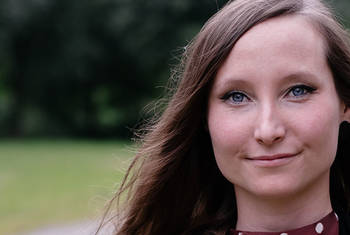Silvia Vidal Melgosa How Do Microalgae Remove Carbon from the Atmosphere?
Since 2015, Silvia Vidal Melgosa has been a postdoctoral researcher in the MARUM MPG Group for Marine Glycobiology at the Max Planck Institute for Marine Microbiology. Having completed undergraduate and postgraduate degrees at the University of Barcelona, Vidal Melgosa was awarded her PhD at the University of Copenhagen in 2015. Her research interests include the marine carbon cycle, cell wall biology and the polysaccharide composition of microalgae. The joint holder of two patents, Vidal Melgosa’s research has appeared in numerous journals including Nature Communications, The Plant Cell and The Journal of Biological Chemistry.
Area of Research
Glycobiology
since 2015
Postdoctoral Researcher
Max Planck Institute for Marine Microbiology (more details)
with Prof. Dr. Jan-Hendrik Hehemann. Group of Marine Gycobiology.
2011-2015
PhD in Biotechnology
University of Copenhagen
Department of Plant and Environmental Sciences
Supervisor: Prof. William G. T. Willats.
2005-2009
Second cycle degree in Food Science and Technology
Universitat de Barcelona
Faculty of Pharmacy
2006-2006
Internship
Analytic Laboratory Valls, Spain
2005-2005
Internship
Clinical Analysis Laboratory of Pius Hospital, Valls, Spain
2000-2005
Bachelor in Biology
Universitat de Barcelona
Faculty of Biology

Max Planck Institute for Marine Microbiology
BremenAt the Max Planck Institute for Marine Microbiology (MPIMM), we are investigating microorganisms in the sea and other waters. What role do they play, what are their characteristics and how great is their biodiversity? What is the contribution of microorganisms to the global cycles of carbon, nitrogen, sulfur and iron? What does this mean for our environment and our climate? These and many other questions will be answered by researchers from around the world, engineers, technicians and numerous others at the MPIMM. Their fields of expertise range from microbiology to microsensors, geochemistry to genome analysis and molecular ecology to modelling.
The MPIMM was founded in 1992 and is part of the Max Planck Society (MPG). Since 2002, the MPIMM has been running the International Max Planck Research School of Marine Microbiology (MarMic), a program for highly qualified master students and graduates of our institute and the Bremen Research Alliance partner Bremen University, Alfred Wegener Institute Helmholtz Center for Polar and Marine Research (AWI) and Jacobs University.
Department
MARUM MPG Bridge Group Marine Glycobiology
Algal polysaccharides are an important component of the flux of carbon rich organic matter from the surface ocean into its depth. Most marine polysaccharides are synthesized at the surface by microalgae whose annual production is on par with all plants on land even though they only account for about 1-2% of the marine biomass.
This competitive production is caused by intense growth and short lifespans; microalgae live fast and die young (weeks) compared to terrestrial plants (years). They pursue a boom and bust life style with rapid growth and abrupt population crashes whereby algal blooms can appear and disappear within weeks or even days. During growth and upon death microalgae secrete copious amounts of anionic polysaccharides. These are known to spontaneously aggregate into particles, which can more rapidly sink through the water column and inject carbon into deeper waters (the biological pump). Bacteria colonize particles and use enzymes to recycle polysaccharides leading to intense bacterial growth and particle dissolution. This way the interplay between particle formation and its dissolution may regulate the biological pump and dictate how much carbon is stored in the oceans.
Despite the relevance of this process the structures of algal polysaccharides and their recycling by marine microbes remain a mystery. To shed light on this black box of the marine carbon cycle we study the functional evolution of the bacterial enzymatic machines and how they process algal polysaccharides in the ocean
Map
Global warming means that mankind needs to find ways to remove carbon from the atmosphere. In this video, SILVIA VIDAL MELGOSA highlights the fact that microalgae remove as much carbon as all plants on land and considers what we can learn from these natural processes. Collecting samples during a three month microalgae bloom in the North Sea, Vidal Melgosa underlines the fascinating role played by the polysaccharide molecule sulfated fucan. Resistant to bacteria and encouraging the formation of heavier particles that can sink and thereby store carbon at the bottom of the ocean for millennia, Vidal Melgosa’s analysis of sulfated fucan shows how it could make an important contribution to blue carbon strategies. Further research will explore the global relevance of these findings while also analyzing the contribution of different microalgal polysaccharides.
LT Video Publication DOI: https://doi.org/10.21036/LTPUB101035
Diatom Fucan Polysaccharide Precipitates Carbon During Algal Blooms
- Silvia Vidal-Melgosa, Andreas Sichert, T Ben Francis, Daniel Bartosik, Jutta Niggemann, Antje Wichels, William GT Willats, Bernhard M Fuchs, Hanno Teeling, Dörte Becher, Thomas Schweder, Rudolf Amann and Jan-Hendrik Hehemann
- Nature communications
- Published in 2021









